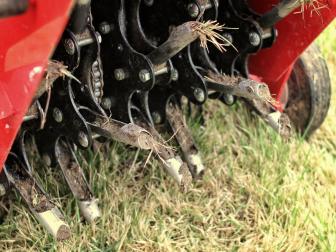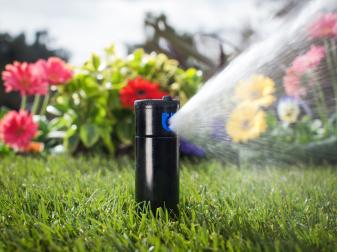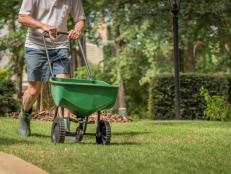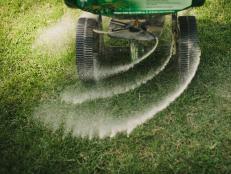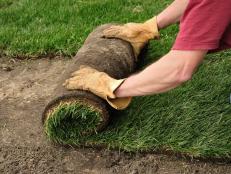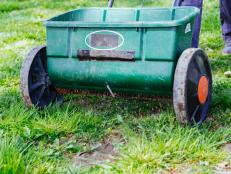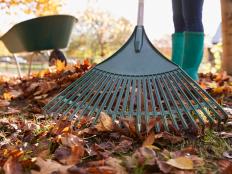How to Dethatch a Lawn
Learn how to tell if your grass is suffering from too much thatch and get expert advice on how to dethatch your lawn for a healthy yard.
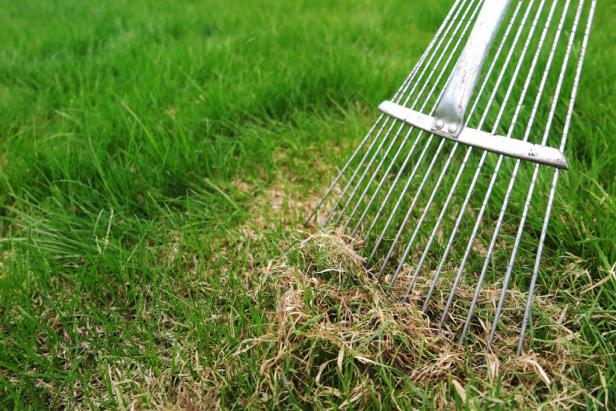
Shutterstock/photowind
Dethatching your lawn may be as simple as using a stiff spring-tined fan rake to remove an excessive layer of dead organic materal between the green of your grass and the soil.

Giving your lawn its best chance to grow into a lush carpet of green includes removing excessive thatch — dead, organic material lying below the canopy of your grass.
Dethatching your lawn is a simple DIY job and likely can be done with a stiff, spring-tined fan rake. But knowing when to dethatch your lawn, and if your lawn needs dethatching in the first place, is essential.
Why Dethatching is Important
A thatch layer consists mostly of dead rhizomes, stolons, stems and roots that build up faster than they can decompose and become matted down between the green grass and the soil surface.
An excessive build up of thatch can create an environment that harbors pests and disease and could prevent the soil from getting the nutrients and water that grass needs to grow, says Clint Waltz, a turfgrass extension specialist with the University of Georgia.
Thatch can develop more quickly when there's excessive grass growth due to overwatering and over fertilizing, cutting grass too short or too infrequently, compacted soil, and soil conditions (such as unfavorable pH levels) discouraging activity from microorganisms that break down the thatch. Your local extension service can help with any soil tests.
A moderate thatch layer serves a purpose. It can protect lawns from foot traffic and decrease soil compaction, acting a bit like a shock absorber for the lawn, says Waltz. Thatch can also act like mulch in a garden bed — slowing water evaporation and insulating soil.
A layer of thatch should not exceed 1/3 inch to 1/2 inch for both cool-season grasses, such as fescue, and warm-season grasses, such bermuda or zoysia.
Signs of Excessive Thatch
Lawns unhealthy due to an overabundance of thatch can appear thin, die from diseases and are less likely to withstand the heat of summer.
Here's a simple way to tell if you might need to dethatch your lawn: Walk across your lawn after a rain and notice how much "spring" is underfoot.
"If your yard is spongy, then dethatching is probably what you need to do," says Waltz.
You can also take samples from your lawn to measure the thickness of your thatch.
When to Dethatch Your Lawn
Dethatch your lawn when the grass is actively growing, so time your dethatching based on grass type.
Warm Season Grasses: For warm season grasses such as zoysia, you could dethatch from May through the summer.
Cool Season Grasses: For cool season grasses such as tall fescue, plan your dethatching for the spring and again in the fall.
Cool season grasses tend to benefit from more frequent dethatching than warm season grasses, says Waltz, but the frequency of dethatching depends on species. Kentucky bluegrass and zoysia might need yearly dethatching while fescue, which produces less thatch material, can be dethatched less often.
How to Dethatch Your Lawn
Dethatching lawns may be as simple as using a stiff, spring-tined fan rake if thatch isn't too heavy. You could also opt for thatching rakes with steel tines made specifically for removing thatch. "You're physically removing organic material that can restrict air, water and nutrients," says Waltz. "If you can open the canopy so you can slightly see through the grass to the soil surface, you're probably effective.
Power rakes — machines about the size of power mowers — and verticutters are more aggressive dethatching options for when the thatch is an inch and a half thick or greater. Mechanical dethatchers such as a power rake can be unwieldy to use and may require help from a professional.
Dethatching when the ground is dry will make it easier to remove the organic matter from the lawn and place in a compost pile or garden bed.
Dethatching can be used along with core aeration, the process of coring holes into your lawn so oxygen, water and nutrients can get to grass roots. While both processes remove organic matter, aeration goes deeper. "If you can feel under your feet that the soil is compacted, then soil aeration is the better practice, where you open the soil up and introduce more air into the root system," says Waltz.
How to Aerate Your Lawn
Lawn aeration encourages deep roots, resulting in a healthy lawn. Learn how to give your grass a breath of fresh air with these aerating tips.
If you're planning to fertilize, it might be best to dethatch or core aerate first. Fertilize a week afterward so more fertilizer makes it to your lawn's root system.
Preventing Excessive Thatch
Waltz says you can mitigate excessive thatch grow by:
- Not overfertilizing your lawn. Follow the manufacturer's directions on the bag of fertilizer and see our tips on proper fertilization.
- Watering to a depth of about one inch per week to encourage deep root growth, but don't over water. See our tips on how to water your lawn.
- Mowing your lawn to the correct height. Here's our guide to cutting to the correct height.
More Lawn Care Advice
How to Water Your Lawn the Right Way
Learn the ins and outs of lawn irrigation, including how long to run the sprinkler.
How to Aerate Your Lawn
Learn how to give your grass a breath of fresh air with these aerating tips.

.-Battle-on-the-Beach-courtesy-of-HGTV.-.jpg.rend.hgtvcom.196.196.suffix/1714761529029.jpeg)




